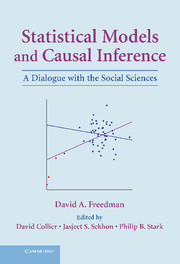Book contents
- Frontmatter
- Contents
- Preface
- Editors' Introduction: Inference and Shoe Leather
- Part I Statistical Modeling: Foundations and Limitations
- Part II Studies in Political Science, Public Policy, and Epidemiology
- Part III New Developments: Progress or Regress?
- 12 On Regression Adjustments in Experiments with Several Treatments
- 13 Randomization Does Not Justify Logistic Regression
- 14 The Grand Leap
- 15 On Specifying Graphical Models for Causation, and the Identification Problem
- 16 Weighting Regressions by Propensity Scores
- 17 On the So-Called “Huber Sandwich Estimator” and “Robust Standard Errors”
- 18 Endogeneity in Probit Response Models
- 19 Diagnostics Cannot Have Much Power Against General Alternatives
- Part IV Shoe Leather Revisited
- References and Further Reading
- Index
14 - The Grand Leap
Published online by Cambridge University Press: 05 June 2012
- Frontmatter
- Contents
- Preface
- Editors' Introduction: Inference and Shoe Leather
- Part I Statistical Modeling: Foundations and Limitations
- Part II Studies in Political Science, Public Policy, and Epidemiology
- Part III New Developments: Progress or Regress?
- 12 On Regression Adjustments in Experiments with Several Treatments
- 13 Randomization Does Not Justify Logistic Regression
- 14 The Grand Leap
- 15 On Specifying Graphical Models for Causation, and the Identification Problem
- 16 Weighting Regressions by Propensity Scores
- 17 On the So-Called “Huber Sandwich Estimator” and “Robust Standard Errors”
- 18 Endogeneity in Probit Response Models
- 19 Diagnostics Cannot Have Much Power Against General Alternatives
- Part IV Shoe Leather Revisited
- References and Further Reading
- Index
Summary
“The grand leap of the whale up the Fall of Niagara is esteemed, by all who have seen it, as one of the finest spectacles in Nature.”
–Benjamin FranklinAbstract. A number of algorithms purport to discover causal structure from empirical data with no need for specific subject-matter knowledge. Advocates claim that the algorithms are superior to methods already used in the social sciences (regression analysis, path models, factor analysis, hierarchical linear models, and so on). But they have no real success stories to report. The algorithms are computationally impressive and the associated mathematical theory may be of some interest. However, the problem solved is quite removed from the challenge of causal inference from imperfect data. Nor do the methods resolve long-standing philosophical questions about the meaning of causation.
Causation, Prediction, and Search by Peter Spirtes, Clark Glymour, and Richard Scheines (SGS) is an ambitious book. SGS claim to have methods for discovering causal relations based only on empirical data, with no need for subject-matter knowledge. These methods–which combine graph theory, statistics, and computer science–are said to allow quick, virtually automated, conversion of association to causation. The algorithms are held out as superior to methods already in use in the social sciences (regression analysis, path models, factor analysis, hierarchical linear models, and so on).
- Type
- Chapter
- Information
- Statistical Models and Causal InferenceA Dialogue with the Social Sciences, pp. 243 - 254Publisher: Cambridge University PressPrint publication year: 2009

